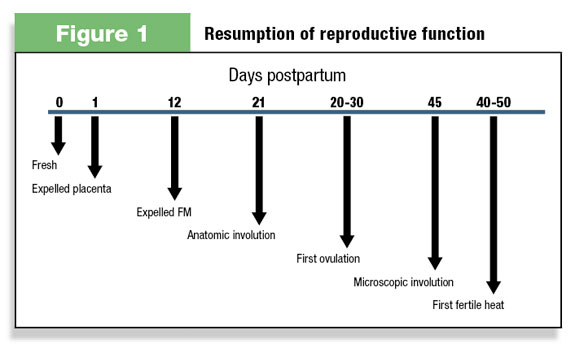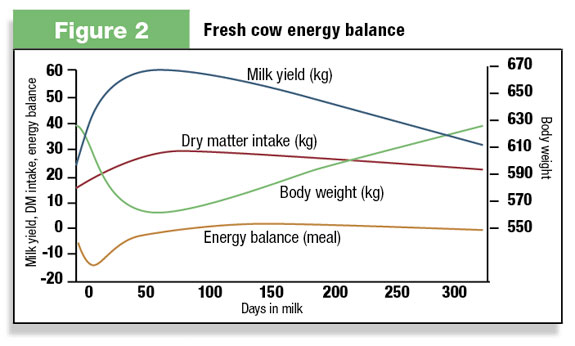Management and environmental factors account for about 96 percent of fertility variation in a dairy operation. Our challenge is what are those factors affecting fertility, and how do we help improve them? The answer to this question is too broad to summarize in this article, as it includes facilities, nutrition, overcrowding, semen handling, A.I. technique, etc. In this article, I will summarize challenging issues that are frequently found on U.S. dairy operations while conducting on-farm visits.
It all comes down to prevention. When a fertility issue shows up on a farm, there is usually a common factor that is not related to individual cows. After reviewing all possible explanations at a dairy, we can classify the potential problems in one or more of the following three management areas: dry, fresh or transition pen; issues affecting the entire herd; and recent changes. Please note that infectious diseases are not included in these areas, but they should be considered and discussed with your herd veterinarian.
Dry, fresh or transition pen
Many fertility issues are nothing else but the consequence of management errors which occurred several weeks or months prior. For example, incidence of peripartum diseases or impact of negative energy balance (NEB) will affect fertility later on. Unfortunately, such negative effects on fertility won’t be noticed until cows are well advanced in lactation. Monitoring and striving for cow comfort during these periods is an effective way to guarantee high peak and persistency of lactation, healthy cows, and good fertility to first insemination, given that voluntary waiting (VWP) period is appropriate.
There is a red flag that can be used to monitor issues during dry, transition and fresh cow group. Monitoring fertility by number of insemination usually gives you a good indication if the cows are reaching first insemination at their maximum potential. Higher conception rate to second or greater insemination is usually associated with peripartum diseases or too early VWP.

Figures 1 and 2 illustrate important physiological and nutritional reasons not to set a VWP earlier than 50 days in milk (DIM). It is important to keep in mind that the cow needs to be gaining bodyweight or body condition score to have good chances of conception.
You need to regularly review compliance for the transition and fresh cow protocol and comfort on your farm to guarantee that your cows are set to a good start.

For transition, such review involves separating mature cows from first-calving heifers, bedding pack space (greater than 90 to 100 square feet per cow), dry and clean bedding, ventilated areas with proper airflow, feedbunk space (greater than 3 feet per cow), water drinkers (3 to 4 inches per cow) and two-plus drinkers per pen and appropriate heat abatement systems.
For fresh cows, in addition to cow comfort and sorting by lactation group, you can design you own protocol with assistance of your herd veterinarian. In general, it may include daily checks for 10 to 14 days for temperature, ketosis, dry matter intake (DMI), milk production, mastitis, DA, lameness and uterine conditions (odor, fluids, etc); before they are moved to production groups. Special care should be provided to cows of known high risk, such as cows calving with twins, having dystocia, cows that are fat, etc. Your veterinarian should decide the treatments to follow upon the presentation of any of these conditions.
For your cows, this is just like the pit garage getting ready for a race car, so if you fail setting them right, they won’t perform. Attention to every detail provided during these periods, will have a tremendous impact at lessening the normal depression of DMI around calving, avoiding stress for competition (especially first-calving heifers), avoiding the bacterial load the cow is being exposed to during a period of normal immune depression, etc.
Depression of DMI is an important factor linked to a wide array of peripartum diseases leading to production and reproduction failure; thereby any effort to avoid this drop in DMI will give the cow more chances for success. As you can imagine, all those factors related to cow comfort and stress will have a negative impact on DMI.
Issues affecting the entire herd
It is interesting as a farm outsider that it is rather easy to see these type of mistakes. It seems like people get used to doing something incorrectly over and over to the point they don’t see it as a mistake anymore – it becomes a normal practice.
For example, thawing semen for 20 to 30 seconds instead of the recommended greater than 45 seconds is a common mistake in some South American countries. Of course they are getting some cows pregnant, but there is a good number of pregnancies they are giving up by doing this.
Yet, they don’t realize there is something wrong on the A.I. procedure and keep blaming the weather, the nutritionist or even an infectious disease.
Another example is on overfeeding protein, which increases the amount of urea in blood, creating a toxic environment for the semen and the embryo if fertilization occurs. This condition can be diagnosed by testing for Milk Urea Nitrogen or Blood Urea Nitrogen.
Similar to the section above, cow comfort also plays a critical role here. For example, there are some simple “chronic” problems that can affect heat expression and increase embryonic loss. Oftentimes heat stress is overlooked, and producers are always trying to find more complex explanations or probably reasons less expensive to fix. The negative effect of heat stress can be easily seen when pulling a fertility report by calendar month from a farm computer.
Now, if on top of that you add overcrowding, you are really hurting your production and reproduction performance. Remember, cow comfort and DMI go side by side, thus any factor affecting cow comfort affects DMI and fertility. In general it is recommended less than 85 percent occupancy in transition and fresh cow pens, and no more than 100 percent in production groups.
As far as heat abatement systems, consider the holding area as first priority for fans and sprinklers, along with having fresh water available. Normally, cows will spend about three to four hours per day in the waiting area and the parlor standing, stressed, overcrowded, with no access to feed or water.
A second priority is heat abatement systems on the feed alley, with the goal of increasing DMI to keep the cows going. Since cows should spend about eight hours per day eating, another good strategy is putting rubber mats on the feed alley, so cows feel more comfortable while eating.
A third priority is the stalls to enhance resting. Cows need about 12 hours per day resting in stalls. If they don’t feel comfortable lying in the stalls, they will prefer to stay standing in the alleys (higher risk of lameness) and sometimes lying in the alleys if there is better airflow than the stalls.
Recent changes
Due to obvious reasons, these issues are typical of expanding herds, but are not exclusive to them. For example, moving animals to new pens will require about a week for the new cow to find her hierarchy in the group, adapt to new herdmates, new environment and diet.
Meanwhile, her DMI will be depressed, affecting production and reproduction. As a result, it is not recommended to move cows between groups unless it is necessary. In addition, moving cows around calving should be avoided, and cows should be moved to transition group at least three or even four weeks before expected calving date.
Nutritional changes are also important, but are not discussed here, since they are extremely herd-specific and should be tracked by your nutritionist.
From the reproduction standpoint, most of the time these issues are related to particle size and development of SARA, leading to laminitis, as well as depressed DMI or overfed protein. Never underestimate semen handling, A.I. procedure and heat detection accuracy. It is always a good idea to have an A.I. refresher course for all new and existing farm A.I. technicians.
In summary, production and reproduction success begin prior to calving. Research has linked cow comfort and DMI to animal performance, so producers need to strive for cow comfort in order to enhance DMI to set cows for a good start. Achieving optimal cow comfort involves bedding cleanness, airflow, avoiding overcrowding, availability of fresh feed and water 24/7 and separating mature cows from first-lactation heifers. Monitor cows’ health and performance in early lactation and use lab tests whenever necessary to diagnose metabolic diseases. PD
Humberto Rivera
Reproductive Specialist
Accelerated Genetics hrivera@accelgen.com





